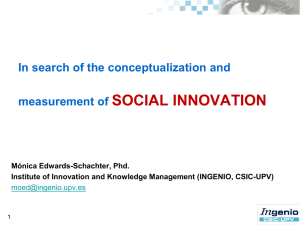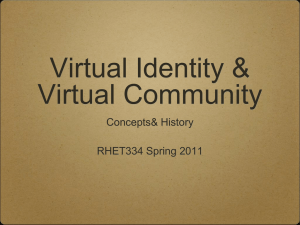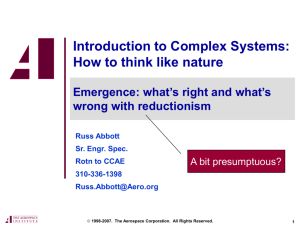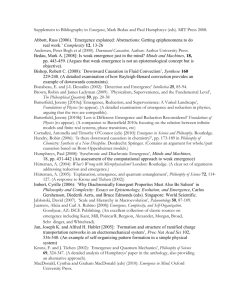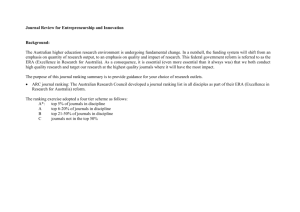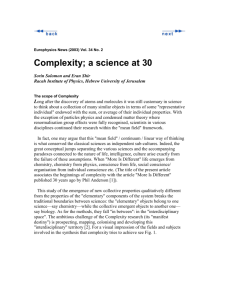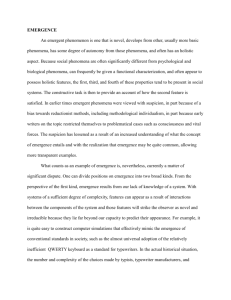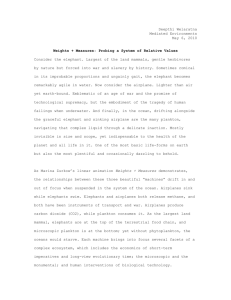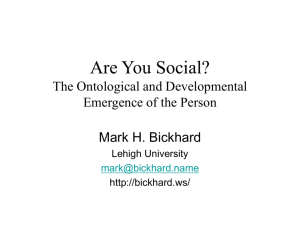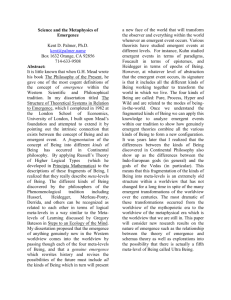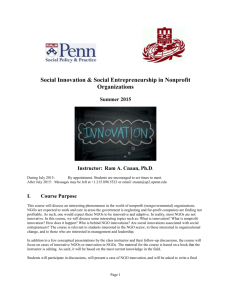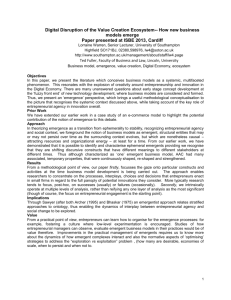social innovation
advertisement
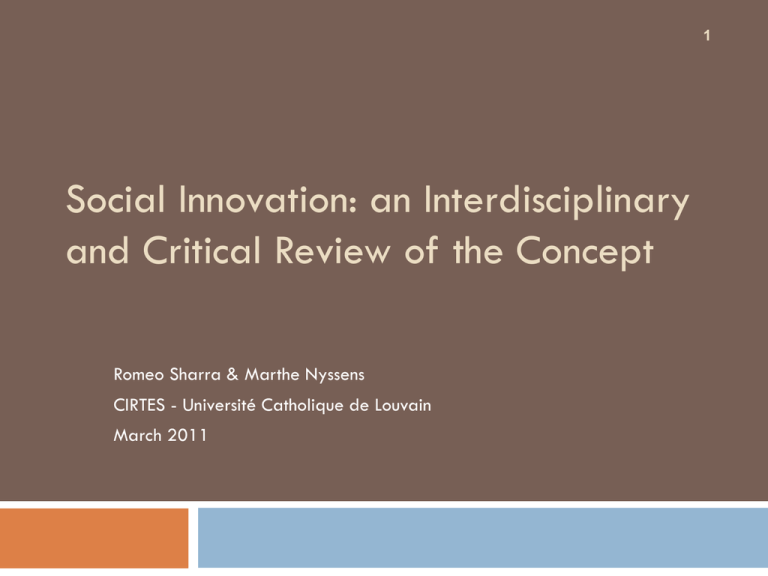
1 Social Innovation: an Interdisciplinary and Critical Review of the Concept Romeo Sharra & Marthe Nyssens CIRTES - Université Catholique de Louvain March 2011 Overview 2 1. 2. 3. 4. 5. 6. 7. Introduction The emergence of the concept Social innovation as an outcome Social innovation as a process Towards an integrated framework of social innovation Conclusion Further research Introduction 3 EU’s “Renewed social Agenda”, BEPA workshop and report on social innovation President Obama creates “The Office of Social Innovation and Civic Participation (SICP)” Australia & New Zeeland have established their centers for social innovation Spain wants to create its “Social Silicon Valley” South Korea and “The Hope Institute” etc. Introduction 4 Some recent examples of SI: Microcredit Fair and alternative finance trade E-learning WISE The Open University Carpool Etc. Introduction 5 But SI is not an exclusivity of our times: Back in the 19th c. mutual societies, cooperatives, and non-profits were founded to improve the living conditions of marginalized urban workers Progressive establishment of the Welfare State (unemployment benefits , healthcare systems, etc.) Although an old phenomenon, social innovation remains relatively understudied in the scientific literature Introduction 6 The interest for this concept/field is growing Creation of research centers: CERISIS: Centre de recherche pour la solidarité et l'innovation sociale Centre de recherche sur les IS (CRISES) à l’UQAM – Québec The INSEAD Social Innovation Centre CSI (Stanford Graduate School of Business), etc. Creation of journals Stanford Social Innovation Review Philadelphia Social Innovations Journal Journal of Social Entrepreneurship etc. The emergence of the concept 7 A polysemous and unstable concept Every innovation is social (Callon 2007) SI refers to the social organization of a production system where social structure and technical system are combined in an optimal way (DeBresson 1993) “A novel solution to a social problem that is more effective, efficient, sustainable, or just than existing solutions and for which the value created accrues primarily to society as a whole rather than private individuals” (Phills et al. 2008) The emergence of the concept 8 2 main fields mobilize the concept of SI SOCIAL ENTREPRENEURSHIP LOCAL DEVELOPMENT Leadbeater (1997) Moulaert (2002), Dees (1998) Vachon (2001) Kramer (2005) Nussbaumer & Moulaert (2007) Ashoka Etc. Etc. The emergence of the concept 9 Social innovation and social entrepreneurship « Social entrepreneurs play the role of change agents in the social sector, by: •Adopting a mission to create and sustain social value (not just private value), •Recognizing and relentlessly pursuing new opportunities to serve that mission, •Engaging in a process of continuous innovation, adaptation, and learning, •Acting boldly without being limited by resources currently in hand, and •Exhibiting heightened accountability to the constituencies served and for the outcomes created ». Dees (1998) Social entrepreneurs are “people with new ideas to address major problems who are relentless in the pursuit of their visions, people who simply will not take “no” for an answer, who will not give up until they have spread their ideas as far as they possibly can” Bornstein (2007) The emergence of the concept 10 Social innovation and local development The macroeconomic, centralized and “top-down” policies have failed to reduce disparities between regions, especially in an urban context. Moulaert, 2002 New approaches to local development have emerged which focus on the exploitation and promotion of the endogenous potentialities of the territory. Vachon 2001 Birth of the Integrated Area Development (IAD) which is based on social innovation. « The integrating dynamics had to come from ‘social innovation’ in at least two senses: 1. social innovation through the satisfaction of unsatisfied or alienated human needs; 2. and, innovation in the social relations between individuals and groups in neighborhoods and the wider territories embedding them” Moulaert et al. 2005 Social Innovation as an outcome 11 Phills et al (2008) “A novel solution to a social problem that is more effective, efficient, sustainable, or just than existing solutions and for which the value created accrues primarily to society as a whole rather than private individuals” Mulgan (2007) “ innovative activities and services that are motivated by the goal of meeting a social need and that are predominantly developed and diffused through organizations whose primary purposes are social” These definitions are made of 3 parts : 1. Novelty and improvement => new does not necessarily mean totally novel or unseen but rather different or alternative and/or more efficient than current practices; 2. A clear and explicit aim to solve a social problem; 3. In order to create social value rather than private value, i.e. gains for entrepreneurs, investors and ordinary (not disadvantaged) consumers. Social Innovation as an outcome 12 According to Lévesque (2001), SI is not always motivated by an unmet social need but it can also stem from an aspiration for a different society, e.g. more egalitarian, more human or more environmental-friendly => cf. 1968 Sometimes necessity and aspiration(s) can be combined => cf. fair trade. Social Innovation as a process 13 How does SI emerge, is adopted and then diffused? Starting point: the awareness of a need that is not being met => condition of necessity (Defourny & Develtere, 2009) The involvement of a complex network of formal and/or informal partnerships between various stakeholders “In most cases the success of the innovation will rest on the participation and involvement of a wide variety of interests – the users and beneficiaries of the innovation as well as the producers and suppliers” Murray et al. (2010) Social Innovation as a process 14 Mulgan (2007) “ some of the most effective methods for cultivating social innovation start from the presumption that people are competent interpreters of their own lives and competent solvers of their own problems” Alvord, Brown, & Letts (2003) “ successful social entrepreneurship involves innovations that mobilize existing assets of marginalized groups to improve their lives”. EMPOWERMENT Individuals can acquire the skills to improve their own lives Social Innovation as a process 15 Need + idea of how it could be met First prototypes: trial & error « Scaling up » & diffusion Learning and continual adaptation “innovative efforts to solve persistent social problems (…) that to some extent have been successful in scaling up their impact and at least potentially catalyzing social transformation” Kramer(2005) « innovative solutions to immediate social problems and also mobilize ideas, capacities, resources, and social arrangements required for long-term, sustainable, social transformation » Alvord et al. (2003) Social innovation: an integrated framework 16 These 2 definitions are complementary rather than mutually exclusive: “Our interest is in innovations that are social both in their ends and in their means. Specifically, we define social innovations as new ideas (products, services and models) that simultaneously meet social needs and create new social relationships or collaborations. In other words, they are innovations that are both good for society and enhance society’s capacity to act”. Murray et al. 2010 Social innovation: an integrated framework 17 DRIVERS: they define the raison d'être and the mission of every SI. TARGET = main beneficiary of the SI • Individuals => alcoholics, jobseekers, etc. • Organizations => companies, schools, etc. • Territories => neighborhoods, cities, etc. Conclusion 18 Social innovation: a “new-born” in the scientific literature but who is growing rapidly. 2 main literatures mobilize the concept => SE et IAD. 2 complementary approaches to define SI => outcome and process. Drivers + Process + Outcome + Target = an integrated framework of SI Further research 19 A typology of SI in social economy in Brussels: exploratory interviews. An empirical study on the mechanisms of SI and its organizational and institutional determinants: case study approach. The added-value of SI and its importance for public policy. 20 Thank you for your attention and feedback!
